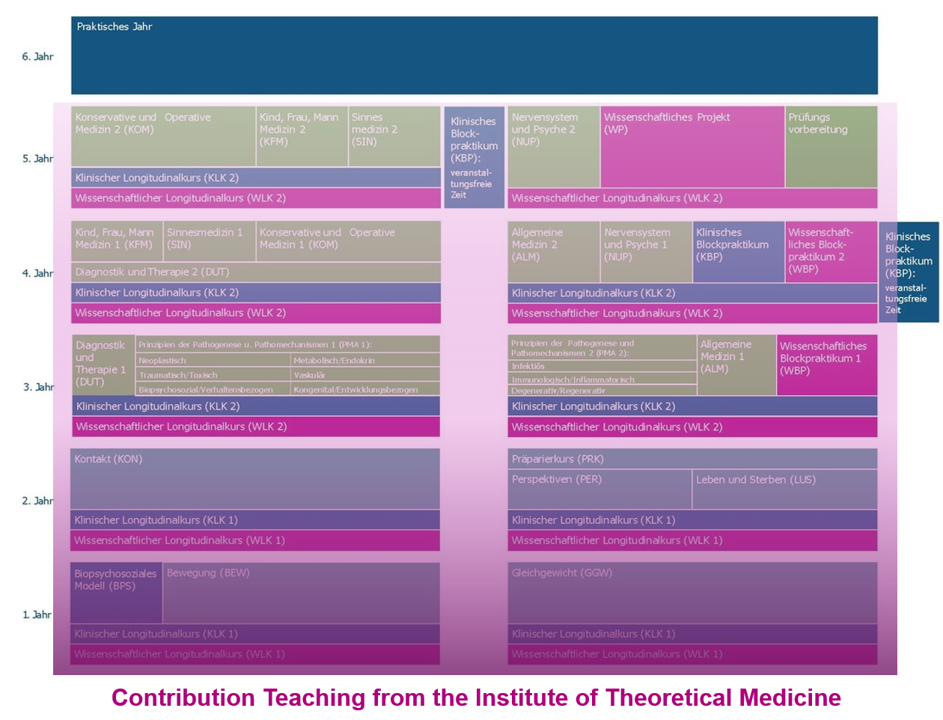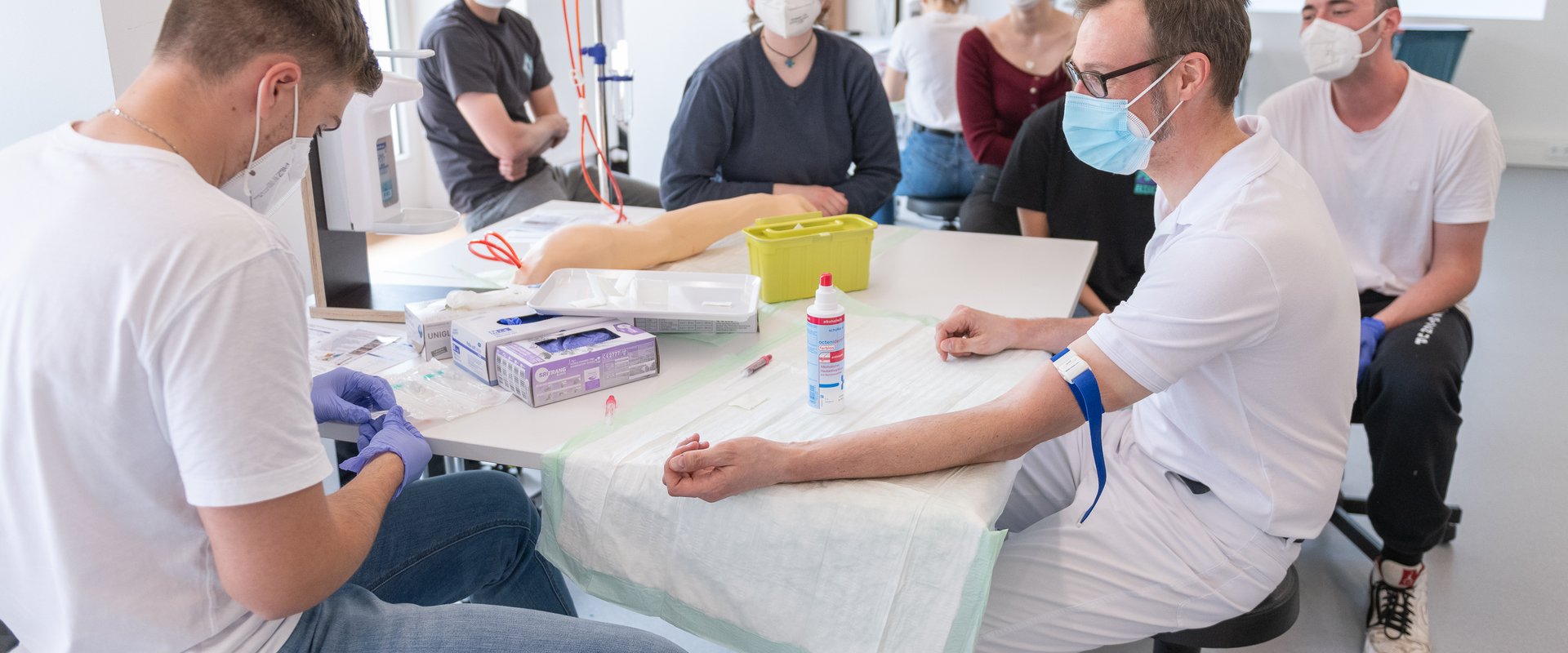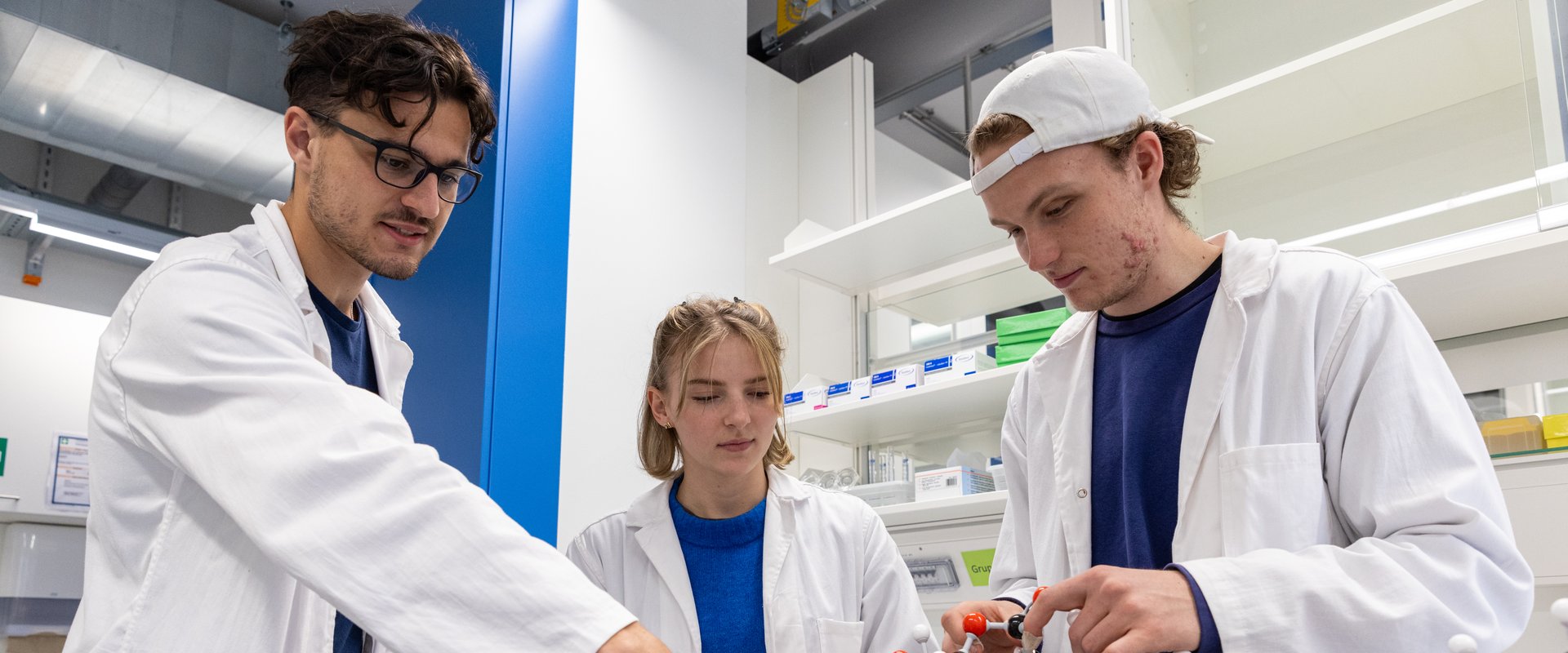Overview of the curriculum

Courses offered by the ITM in the Model Degree Programme in Human 伟德国际_伟德国际1946$娱乐app游戏icine
Modules first study section:
The bio-psycho-social model is a central guiding principle of the medical degree programme in Augsburg. The model follows an integrative medical approach that understands illness not purely mechanistically, but as a disorder of the interaction of physical, psychological and social factors - exemplified by the topics of pain and stress. The content is taught primarily by medical psychology and sociology in co-operation with clinical subjects.
In the movement module, basic scientific principles are taught as well as the functions of the structure and function of the musculoskeletal system, cardiovascular system and respiratory tract. The content is taught integratively by the chairs of Anatomy and Cell Biology, Biochemistry and Molecular Biology, and Physiology as well as numerous clinical subjects in close co-operation. Using common clinical conditions such as myocardial infarction or pneumothorax, students learn from the outset to think across disciplines and to connect their foundational knowledge with clinical application.
?
This module focuses on how the human body maintains homeostasis. It covers the structure, function, and common clinical conditions of the endocrine system, digestive tract, urogenital system, and blood, always with reference to clinical application. The content is taught in an integrated manner through close collaboration between the departments of Anatomy and Cell Biology, Biochemistry and Molecular Biology, 伟德国际_伟德国际1946$娱乐app游戏ical Psychology and Sociology, Physiology, and a range of clinical disciplines.
?
This module provides foundational knowledge and skills related to the processes that govern the interaction between the human body and its environment. Key focus areas include the structure, function, and common clinical conditions of the nervous system, sensory systems, immune system (including fundamentals of microbiology), and the skin. The acquired knowledge is applied to clinical case scenarios. Teaching is delivered in an integrated format through close collaboration between the departments of Anatomy and Cell Biology, Biochemistry and Molecular Biology, Microbiology, 伟德国际_伟德国际1946$娱乐app游戏ical Psychology and Sociology, Physiology, and various clinical disciplines.
?
This module builds on the foundational knowledge of human structure and function, shifting the focus toward the individual patient and the broader healthcare system. It covers topics such as health economics, healthcare policy and systems, medical history, theory, and ethics. These aspects are further explored through work shadowing opportunities outside the clinical setting. The module also includes content from general medicine and cross-sectoral clinical care.
?
<meta charset="UTF-8">Involved ITM chairs:
– 伟德国际_伟德国际1946$娱乐app游戏ical Psychology and Sociology
This module, closely linked to the dissection course and building on the content of semesters 1–3, introduces an integrative model of disease and teaches fundamental concepts of pathophysiology.<meta charset="UTF-8">
?
Involved ITM chairs:
– Anatomy and Cell Biology
– Biochemistry and Molecular Biology
– 伟德国际_伟德国际1946$娱乐app游戏ical Psychology and Sociology
– Physiology
An essential component of medical education in anatomy is the dissection and visualisation of human body regions and organs. Under close supervision, students work in small groups to dissect anatomical structures, enabling them to gain a hands-on understanding of the human body’s architecture. The course is structured into three main areas: the musculoskeletal system, internal organs, and the central nervous system.
?
Topographic anatomy is taught in accompanying lectures provided by the Department of Anatomy and Cell Biology. Sectional anatomy is integrated with the support of the Department of Diagnostic and Interventional Radiology. In addition, the Institute of Pathology and Molecular Diagnostics introduces students to the diagnosis of pathological changes.
?
The course also addresses key ethical aspects of medical education, including respectful handling of human remains and the sensitive discussion of death and dying.
?
Scientific thinking and practice are essential for making informed diagnostic and therapeutic decisions. The aim of the Scientific Longitudinal Course I is to introduce medical students to the fundamentals of scientific work and to develop key research skills.
?
Involved ITM chairs:
– Anatomy and Cell Biology
– Biochemistry and Molecular Biology
– 伟德国际_伟德国际1946$娱乐app游戏ical Psychology and Sociology
– Physiology
Involved ITM chairs:
– 伟德国际_伟德国际1946$娱乐app游戏ical Psychology and Sociology
?
Modules second study section:
This module spans two semesters (5 and 7) and begins with a block phase introducing students to instrumental and laboratory diagnostics, general pathology, and pharmacotherapy, laying the groundwork for the clinical medicine modules. Subject-specific content on diagnostics, therapy, pathophysiology, and pathology is then integrated into the individual clinical disciplines.
?
Involved ITM chairs:
– Anatomy and Cell Biology
– Biochemistry and Molecular Biology (e.g. pharmacology of antidiabetics, toxicology)
This module extends in two parts over semesters 7 and 9 and is intended to focus on clinical pictures of internal medicine, surgery and anaesthesiology and their interfaces.
Supplementary content from laboratory medicine, radiology, pathology, pharmacology, orthopaedics, physical and rehabilitative medicine and physical therapy can also be found here to enable students to treat the clinical pictures covered in a professional manner.
?
Involved ITM chairs:
– Biochemistry and Molecular Biology
– Physiology
This module extends over two semesters (7th and 9th semesters). Disease patterns from gynaecology and obstetrics, paediatrics and urology are addressed here, supplemented by overarching aspects of internal medicine, laboratory medicine, pharmacology, radiology and pathology.
?
Involved ITM chairs:
–?Anatomy and cell biology (e.g. lymphatic drainage, congenital malformations)
–?Biochemistry and molecular biology (immunological memory and vaccination)
This module spans the 7th and 9th semesters and focuses on disease patterns in dermatology, ENT, ophthalmology, and neurology. These are complemented by cross-cutting topics from laboratory medicine, radiology, pathology, pharmacology, and surgery.
?
?
Involved ITM chairs:
– Physiology
This module extends over two semesters (8th and 10th semesters). Disease patterns from neurology, psychiatry and psychosomatics are addressed here, supplemented by overarching aspects of laboratory medicine, radiology, pathology, pharmacology, physical and rehabilitative medicine and physical therapy.
?
Involved ITM chairs:
– Anatomy and Cell Biology
– 伟德国际_伟德国际1946$娱乐app游戏ical Psychology and Sociology
– Physiology
This module spans the 6th and 8th semesters and builds on the Perspectives module by addressing relevant clinical conditions. It covers topics in general medicine, emergency and intensive care, pain medicine, and geriatrics, as well as occupational, social, and forensic medicine.
?
Involved ITM chairs:
– Physiology
Involved ITM chairs:
– Anatomy and Cell Biology
– Biochemistry and Molecular Biology
– 伟德国际_伟德国际1946$娱乐app游戏ical Psychology and Sociology
– Physiology
Involved ITM chairs:
– Anatomy and Cell Biology
– Biochemistry and Molecular Biology
– 伟德国际_伟德国际1946$娱乐app游戏ical Psychology and Sociology
– Physiology
This module extends over two semesters (5th and 6th semester).
?
Involved ITM chairs:
– Anatomy and Cell Biology
– Physiology
As part of the scientific project during the 10th semester, students of human medicine have the opportunity to work independently on current research topics.
?
Involved ITM chairs:
– Anatomy and Cell Biology
– Biochemistry and Molecular Biology
– 伟德国际_伟德国际1946$娱乐app游戏ical Psychology and Sociology
– Physiology





